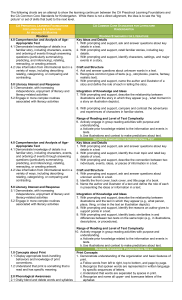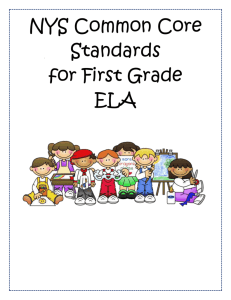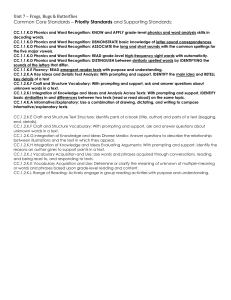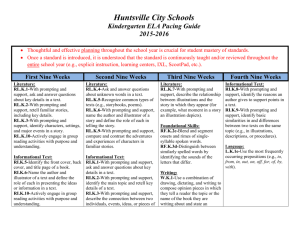Kindergarten - Fleming County Schools
advertisement
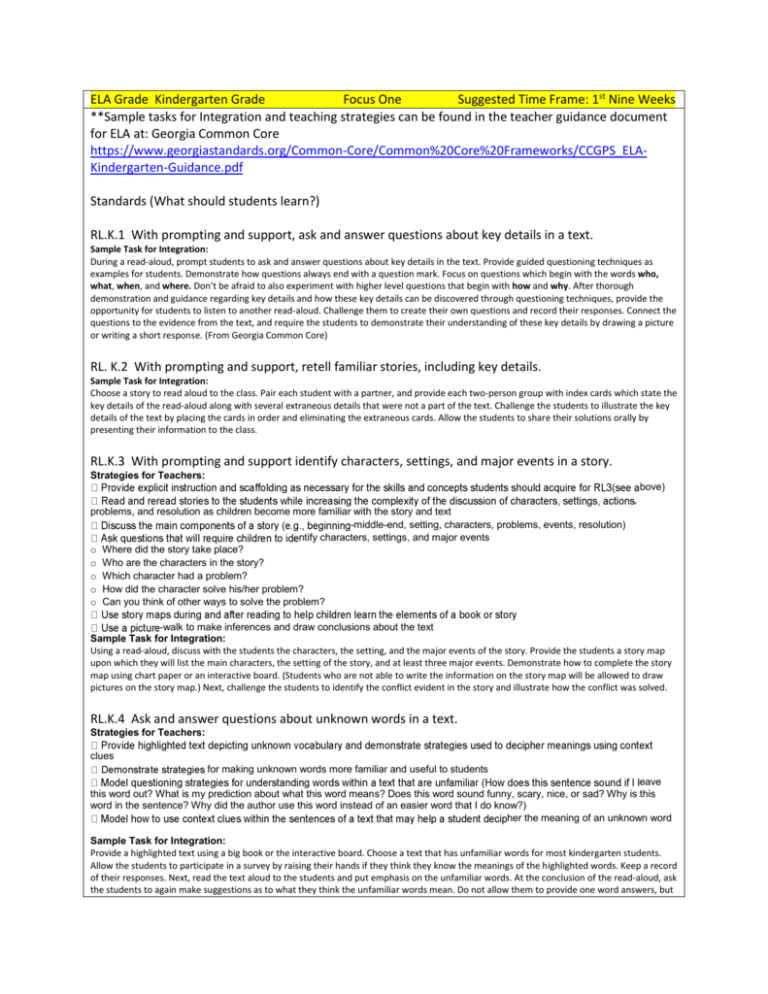
ELA Grade Kindergarten Grade Focus One Suggested Time Frame: 1st Nine Weeks **Sample tasks for Integration and teaching strategies can be found in the teacher guidance document for ELA at: Georgia Common Core https://www.georgiastandards.org/Common-Core/Common%20Core%20Frameworks/CCGPS_ELAKindergarten-Guidance.pdf Standards (What should students learn?) RL.K.1 With prompting and support, ask and answer questions about key details in a text. Sample Task for Integration: During a read-aloud, prompt students to ask and answer questions about key details in the text. Provide guided questioning techniques as examples for students. Demonstrate how questions always end with a question mark. Focus on questions which begin with the words who, what, when, and where. Don’t be afraid to also experiment with higher level questions that begin with how and why. After thorough demonstration and guidance regarding key details and how these key details can be discovered through questioning techniques, provide the opportunity for students to listen to another read-aloud. Challenge them to create their own questions and record their responses. Connect the questions to the evidence from the text, and require the students to demonstrate their understanding of these key details by drawing a picture or writing a short response. (From Georgia Common Core) RL. K.2 With prompting and support, retell familiar stories, including key details. Sample Task for Integration: Choose a story to read aloud to the class. Pair each student with a partner, and provide each two-person group with index cards which state the key details of the read-aloud along with several extraneous details that were not a part of the text. Challenge the students to illustrate the key details of the text by placing the cards in order and eliminating the extraneous cards. Allow the students to share their solutions orally by presenting their information to the class. RL.K.3 With prompting and support identify characters, settings, and major events in a story. Strategies for Teachers: bove) , problems, and resolution as children become more familiar with the story and text -middle-end, setting, characters, problems, events, resolution) ntify characters, settings, and major events o Where did the story take place? o Who are the characters in the story? o Which character had a problem? o How did the character solve his/her problem? o Can you think of other ways to solve the problem? -walk to make inferences and draw conclusions about the text Sample Task for Integration: Using a read-aloud, discuss with the students the characters, the setting, and the major events of the story. Provide the students a story map upon which they will list the main characters, the setting of the story, and at least three major events. Demonstrate how to complete the story map using chart paper or an interactive board. (Students who are not able to write the information on the story map will be allowed to draw pictures on the story map.) Next, challenge the students to identify the conflict evident in the story and illustrate how the conflict was solved. RL.K.4 Ask and answer questions about unknown words in a text. Strategies for Teachers: clues for making unknown words more familiar and useful to students eave this word out? What is my prediction about what this word means? Does this word sound funny, scary, nice, or sad? Why is this word in the sentence? Why did the author use this word instead of an easier word that I do know?) her the meaning of an unknown word Sample Task for Integration: Provide a highlighted text using a big book or the interactive board. Choose a text that has unfamiliar words for most kindergarten students. Allow the students to participate in a survey by raising their hands if they think they know the meanings of the highlighted words. Keep a record of their responses. Next, read the text aloud to the students and put emphasis on the unfamiliar words. At the conclusion of the read-aloud, ask the students to again make suggestions as to what they think the unfamiliar words mean. Do not allow them to provide one word answers, but insist that they explain the clues from the story that made them interpret the definition as they did. Provide the correct definitions of the unfamiliar words using a beginning dictionary. Challenge the students to search for unfamiliar words in texts they explore and to use the strategies employed in this activity to predict meanings. They should check their predictions using a beginning dictionary. RI.K.1 With prompting and support, ask and answer questions about key details in a text. Strategies for Teachers: ions about key details in informational text Sample Task for Integration: The teacher will read a book aloud to the class and guide the class to participate in a 3-2-1 activity that will allow them to ask and answer questions about key details in the text. A 3-2-1 is three things they discovered, two things they found interesting, and one question they still have. Students respond to the 3-2-1 in writing and share answers with a partner. RI.K.2 With prompting and support, identify the main topic and retell key details of a text. RI.K.3 With prompting and support, describe the connection between two individuals, events, ideas, or pieces of information in a text. RI.K.4 With prompting and support, ask and answer questions about unknown words in a text. RI.K.5 Identify the front cover, back cover, and title page of a book. RF.K.1 Demonstrate understanding of the organization. a. Follow words from left to right, top to bottom, and page by page. b. Recognize that spoken words are represented in written language by specific sequences of letters. c. Understand that words are separated by spaces in print. d. Recognize and name all upper-and lowercase letters of the alphabet. W.K.1 Use a combination of drawing, dictating, and writing to compose opinion pieces in which they tell a reader the topic or the name of the book they are writing about and state an opinion or preference about the topic or book (e.g., My favorite book is….) W.K.2 Use a combination of drawing, dictating, and writing to compose informative/explanatory texts in which they name what they are writing about and supply some information about the topic. SL.K.1 Participate in collaborative conversations with diverse partners about kindergarten topics and texts with peers and adults in small and larger groups. a. Follow agreed-upon rules for discussions (e.g., listening to others and taking turns speaking about the topics and texts under discussion). b. Continue a conversation through multiple exchanges. SL.K.2 Confirm understanding of a text read aloud or information presented orally or through other media by asking and answering questions about key details and requesting clarification if something is not understood. SL.K.3 Ask and answer questions in order to seek help, get information, or clarify something that is not understood. L.K.1 Demonstrate command of the conventions of standard English grammar and usage when writing or speaking. a. Print many upper-and lowercase letters. b. Use frequently occurring nouns and verbs. Sample Learning Targets (Sample) Sample Strategies, Products, and Assessments I can retell key details from a text read to me. (Formative and Summative*) I can tell about the characters in a story. Practice saying sentences with who, what, where, I can ask questions about unknown words in a text. when, why and how. I can recognize and name all lower and upper-case Read along with an adult as they read a book letters. I can understand and ask questions. I can read some sight words. Academic Vocabulary/Key Terms Vowel, long sound, short sound, front cover, back cover, title page, character, setting, main idea, noun, verb, clarify, Question mark, Key Details, Retell Important Details, Unimportant Details, Story Map, Characters, Setting, Events, Conflict, Main Idea, Compare and Contrast, Dictionary, Synonym, Context Clues types of text (storybook, poetry) stanza, paragraphs, rhyme, Verse, author, illustrator, illustrations, questions, who, where, why, predictions, key events, what, when, how, topic, retell, Informational text connections, ideas, information, dictionary, clues, (left, right, top, bottom page) Words, letters, sequence, recognize, spoken words, letters, written, sequence words, sentences, print features, recognize name, letters, uppercase, lowercase, drawing, dictating, writing left-to-right(pattern of writing) opinion topics, Informative, explanatory, topic information, facts, examples, listen, speak, agree, conversation, peer, adult, diverse, confirm, understand, information orally, media, clarification aloud. Skip words to see if students can say the word Act out the shapes of letters. Say nursery rhymes aloud and talk about the moral and characters. Chant the alphabet daily for fluency. Play Go Fish with sight word cards. *Make an ABC book drawing a picture for each letter. *Take DIBELS or other Oral Reading Fluency test to determine the number of letters read per minute. HeadSprout Suggested Resources (Texts, Art, Music, Media) Nursery Rhymes, classroom library books, big books, children’s songs, music videos for children, flash cards for letter sound/picture correspondence. Little Bear, Are You My Mother, Green Eggs and Ham, Frog and Toad Together, Pancakes for Breakfast, Mix a Pancake, Poem by Langston Hughes, Wouldn’t You?, By Myself, The Wonderful Wizard of Oz, Mr. Popper’s Penguins, Lon Po Po: A Red Riding Hood Story from China, The Owl and the Pussycat, Truck Eduplace for Houghton Mifflin Waltke’s World for Scott Foresman Reading Street Thinkfinity Learnzillion.com Hippocampus.com ELA Grade: Kindergarten Focus TWO Suggested Time Frame: 2nd Nine Weeks Standards (What should students learn?) RL.K.6 With prompting and support, name the author and illustrator of a story and define the role of each in telling the story. RL.K.5 Recognize common types of texts (e.g., storybooks, poems). RI.K.6 Name the author and illustrator of a text and define the role of each in presenting the ideas or information in a text. RF.K.2 Demonstrate understanding of spoken words, syllables, and sounds (phonemes). a. Recognize and produce rhyming words. b. Count, pronounce, blend, and segment syllables in spoken words. c. d. Blend and segment onsets and rimes of single-syllable spoken words. Isolate and pronounce the initial, medial vowel, and final sounds (phonemes) in three-phoneme (consonant-vowel-consonant, or CVC) words * (This does not include CVCs ending with /l/, /r/, or /x/.) e. Add or substitute individual sounds (phonemes) in simple, one-syllable words to make new words. W.K. 3 Use a combination of drawing, dictating, and writing to narrate a single event or several loosely linked events, tell about the events in the order in which they occurred, and provide a reaction to what happened. W.K. 5 With guidance and support from adults, respond to question and suggestions from peers and add details to strengthen writing as needed. SL.K.4 Described familiar people, places, things and events and, with prompting and support, provide additional detail. L.K.1 Demonstrate command of the conventions of standard English grammar and usage when writing or speaking. c. Form regular plural nouns orally by adding /s/ or /es/ (e.g., dog,dogs; wish,wishes). d. Understand and use question words (interrogatives) (e.g., who, what, where, when, why, how). L.K.2 Demonstrate command of the conventions of standard English capitalization, punctuation, and spelling when writing. a. Capitalize the first word in a sentence and the pronoun. b. Recognize and name end punctuation. c. Write a letter or letters for most consonant and short-vowel sounds (phonemes). d. Spell simple words phonetically, drawing on knowledge of sound-letter relationship. L.K. 3 Use knowledge of language and its conventions when writing, speaking, reading, or listening. a. Choose words and phrases for effect.* b. Recognize and observe differences between the conventions of spoken and written standard English. Sample Learning Targets (Sample) Sample Strategies, Products, and Assessments I can name the author and illustrator of a book. (Formative and Summative*) I can name rhyming words. Students will read nonsense words like sim, lut, I can sound out CVC words. zug, oc I can add s or es to make plural words. Students match pictures to a rhyming word. I can punctuate the end of a sentence. *Students make plural nouns adding s and es. *Students circle the rhyming words in a nursery Academic Vocabulary/Key Terms Author, illustrator, segment, punctuate, period, rhyme. question mark, exclamation mark, consonant, CVC *Write consonant beginning of words read aloud words, silent e, magic e words, illustrations, pictures Read poetry aloud in a chant. Story, syllable sounds(phonemes), rhyming, Listen to questions and exclamations read aloud blend(blending), segment(segmenting), initial and tell what punctuation is needed. consonant sound, vowel sound, final consonant sound, Describe familiar people, places or things using consonant-vowel-consonant (CVCwords), substitute, details. add sounds(phonemes), one-syllable word, drawing Web sites for children’s poetry. dictating event, examples, details, cause/effect, order of events (beginning, middle, end) left-to-right pattern of writing Suggested Resources (Texts, Art, Music, Media Books of poetry for children, Picture cards of rhyming words, Children’s song web sites, SmartBoard, Ipad, List of nonsense words. As I Was Going to St. Ives, Singing-Time, Halfway Down, Drinking Fountain, Laughing Boy, Covers, It Fell in the City, Over In the Meadow. Eduplace for Houghton Mifflin Waltke’s World for Scott Foresman Reading Street Thinkfinity Learnzillion.com Hippocampus.com ELA Grade Kindergarten FOCUS THREE Suggested Time Frame: 3rd Nine Weeks Standards (What should students learn?) RL.K. 7 With prompting and support, describe the relationship between illustrations and the story in which they appear (e.g., what moment in a story an illustration depicts). RI.K.7 With prompting and support, describe the relationship between illustrations and the text in which they appear (e.g., what person, place, thing, or idea in the text an illustration depicts). RF.K.3 Know and apply grade-level phonics and word analysis skills in decoding words. a. Demonstrate basic knowledge of one-to-one letter-sound-sound correspondences by producing the primary or many of the most frequent sound for each consonant. b. Associate the long and short sounds with common spellings (graphemes) for the five major vowels. c. Read common high-frequency words by sight (e.g., the, of, to, you, she, my, is, are, do, does). d. Distinguish between similarly spelled words by identifying the sounds of the letters that differ. SL.K.5 Add drawings or other visual displays to descriptions as desired to provide additional detail. L.K.4 Determine or clarify the meaning of unknown and multiple-meaning word and phrases based on grade 3 reading and content, choosing flexibly from a range of strategies. a. Use sentence-level context as a clue to the meaning of a word or phrase. b. Determine the meaning of the new word formed when a known affix is added to a known word (e.g., agreeable/disagreeable, comfortable/uncomfortable, care/careless, heat/preheat). c. Use a known root word as a clue to the meaning of an unknown word with the same root (e.g., company, companion). d. Use glossaries or beginning dictionaries, both print and digital, to determine or clarify the precise meaning of key words and phrases. Sample Learning Targets I can use the pictures to tell the meaning of the story. I can sound out a word. I can read some sight words. I can draw pictures to help tell a story. Academic Vocabulary/Key Terms Illustration, root word, glossary, dictionary, digital pictures, settings, events, connection, characters, topic, details, relationships, phonics, decoding, word analysis, sounds, consonant letter, long/short vowels, spelling, read high-frequency words, sight words, distinguish Sample Strategies, Products, and Assessments (Formative and Summative*) Alphabetimals online flipbook, Zoobooks digital storytelling, SmartBoard and online stories, music, videos to support the standard, phonics and sight words on Mastery Connect. similar spelled words, letters, identifying sounds, visual display, detail, description, drawings, Clarify, familiar, multiple meaning words, phrase, identify, apply, verb, Suggested Resources (Texts, Art, Music, Media) Alphabetimals, Zoobooks digital storytelling,iStorybooks, Mastery Connect, Cool Videos ( The Lorax, Happy St. Patricks Day, Awesome Stories, Visual Vocabulary Builder. Eduplace for Houghton Mifflin Waltke’s World for Scott Foresman Reading Street Thinkfinity Learnzillion.com Hippocampus.com ELA Grade: Kindergarten FOCUS FOUR Suggested Time Frame: 4th Nine Weeks Standards (What should students learn?) RL.K.4 Read emergent-reader texts with purpose and understanding. RL.K.9 With prompting and support, compare and contrast the adventures and experiences of characters in familiar stories. RL.K.10 Actively engage in group reading activities with purpose and understanding. RF.K.4 Read emergent-reader texts with purpose and understanding. RI.K.8 With prompting and support, identify the reasons an author gives to support points in a text. RI.K. 9 With prompting and support, identify basic similarities in and differences between two texts on the same topic (e.g., in illustrations, descriptions, or procedures). RI.K.10 Actively engage in group reading activities with purpose and understanding. W.K.6 With guidance and support from adults, explore a variety of digital tools to produce and publish writing, including in collaboration with peers. W.K.7 Participate in shared research and writing projects (e.g., explore a number of books by a favorite author and express opinions about them). W.K. 8 With guidance and support from adults, recall information from experiences or gather information from provided sources to answer a question. SL.K.6 Speak audibly and express thoughts, feelings, and ideas clearly. L.K.1 Demonstrate command of the conventions of standard English grammar and usage when writing or speaking. e. Use the most frequently occurring prepositions (e.g., to, from, in, out, of, off, for, of, by, with). f. Produce and expand complete sentences in shared language activities. L.K.5 Demonstrate understanding of word relationships and nuances in word meanings. a. Distinguish the literal and non-literal meanings of words and phrases in context (e.g., take steps). b. Identify real-life connections between words and their use (e.g., describe people who are friendly or helpful). c. Distinguish shades of meaning among related words that describe states of mind or degrees of certainty (e.g., knew, believed, suspected, heard, wondered). L.K. 6 Acquire and use accurately grade-appropriate conversational, general academic, and domain specific words and phrases, including those that signal spatial and temporal relationships (e.g., After dinner that night we went looking for them) Sample Learning Targets (Samples) Sample Strategies, Products, and Assessments I can read with a group and tell the meaning of the story. I can read some prepositions. Academic Vocabulary/Key Terms Preposition, literal, non-literal, compare, contrast, adventures, similarities, differences, Characters, experiences, purpose, storybooks, poetry, fairytales, fantasy, nursery rhymes, main idea, detail(s) reason(s), example(s), similarity, difference, compare, contrast, informational text, biography, autobiography graph, chart, map, fluency/fluently, emergent-reader texts, accuracy, automaticity, expression, partner reading, repeated reading, choral reading, oral reading, reader’s theater, connected text, collaboration, digital tools, gather information (research), producing, publishing, research, shared research, opinion resources, recall, question, answer, source, experiences, express clarity thoughts, feelings categories, sort attributes, groups, concept, relationship, frequent, verb, adjective, relate, opposite, antonym, explore, vocabulary connections, real-life, identify relationship, meaning, verb, action, distinguish, acting, shades of meaning, words, phrases, conversations (Formative and Summative*) Mouse in the House activity to show meaning of prepositions. Anything the mouse can do to the house begins with a preposition: (in the house, around the house, by the house, under the house, between the houses) Suggested Resources (Texts, Art, Music, Media) Mastery Connect, eStorybooks, Classroom Libraries, Visual Vocabulary Builder. Eduplace for Houghton Mifflin Waltke’s World for Scott Foresman Reading Street Thinkfinity Learnzillion.com Hippocampus.com

